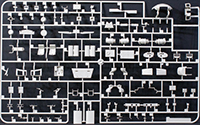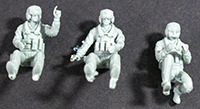
Kitty Hawk Models 1/48 UH-1N Twin Huey Kit First Look
By Michael Benolkin
| Date of Review | May 2019 | Manufacturer | Kitty Hawk Models |
|---|---|---|---|
| Subject | UH-1N Twin Huey | Scale | 1/48 |
| Kit Number | 80158 | Primary Media | Styrene, Photo-Etch, Resin |
| Pros | Best kit of the UH-1N in this scale | Cons | See text |
| Skill Level | Experienced | MSRP (USD) | $TBA |
First Look
 |
 |
 |
 |
 |
 |
 |
In the beginning, Bell developed the first production turbine-powered helicopter to meet a utility aircraft requirement for the United States Army. The prototype first flew in 1956 and under the Army's designation system, this new aircraft was designated HU-1 Iroquois, which is how the aircraft got its widely-used nickname - Huey. When Secretary of Defense McNamara ordered the standardization of aircraft designation across all of the military services, the HU-1 became the UH-1. The UH-1 would evolve with a larger cabin, more powerful engines, and many more missions as all four services put the aircraft to work.
The Canadian Armed Forces was interested in the aircraft, but they wanted a twin-engine capability for additional power and single-out safety. Bell adopted the longer-fuselage used with the UH-1D/H and replaced its single turbine with a pair of PT6T engines driving a wider-chord main rotor and a reversed tail rotor system. The design was successful, but when Bell approached the U.S. DoD with the new aircraft in the early 1970s, they nearly passed on the design because the engines were made in Canada and U.S.-Canada relations were not very good at that time. The DoD would eventually adopt the aircraft into service and it was also sought after in the commercial market where it became the Bell Model 212.
Following the release of their 1/48 UH-1D/H and UH-1Y kits, Kitty Hawk has now released this new-tool 1/48 UH-1N Twin Huey. The kit is molded in light gray styrene and presented on four parts trees, plus one tree of clear parts, one fret of photo-etched details, and three nice resin figures. In the images to the left, the first two trees are the new-tooled UH-1N parts while the second two trees are from their earlier UH-1D/H kit. We'll get to the good and bad of that mix shortly.
Among the features and options in this kit:
- Nicely detailed main rotor head with separately molded rotor blades
- Optional tail boom stiffeners
- Positionable stabilators
- Nicely detailed flight deck
- Nicely detailed armored pilots' seats
- Positionable flight deck doors
- Positionable main cabin sliding doors
- Beautifully detailed main cabin interior
- Chin FLIR turret
- Countermeasures dispensers
- Airframe cable cutters
- Three beautifully cast crew figures
Weapons included:
- Choice of .50 caliber machine gun or minigun for each main cabin door
- Choice of two sizes of rocket pods
Markings are provided for six subjects:
- UH-1N, 158272, USN, NAS Fallon
- UH-1N, 158278, HC-16, BF/103, USN
- UH-1N, 158549, HMLA-773, USMC
- UH-1N, 160178, HMM-268, USMC
- UH-1N, 69-6640, 37 RQF, USAF, F.E. Warren AFB
- UH-1N, 69-6645, USAF
Notes:
- This is one of the best detailed UH-1 kits on the market and offers some great opportunities.
- One 'bug' in the kit is the inclusion of UH-1D/H rotor blades. The UH-1N is equipped with a wider-chord blade with a distinctive trailing edge profile and that doesn't sag as much as the D/H blades. I think I have a relatively simple solution - flatten the pointed trailing edge and laminate thin Evergreen stock to the trailing edge. With some careful sanding and use of Mr.Surfacer, the correct blade profile is doable.
- One 'bug' in the instructions deals with the aircraft's chin. They don't make any mention of an alternative to the USMC's FLIR chin (part D11) even though the profiles and decals show the 'clean' chin. You'll find that part as D24.
- The instructions also have you mount the external weapons mounts, countermeasures, sensors/antennas, etc. which are correct for the USMC aircraft options. Grab some reference photos of your subject to see what should be added or skipped to render your aircraft.
- The rotor head is correct for most of the UH-1Ns out there, though you can do a bit of scratch-building to render the updated rotor head used on Marine UH-1Ns that eliminated the stabilizer bar later in USMC service.
- Take note of the crew figures. The Navy/Marines use a different helmet than the USAF. Note that the pilot figures are equipped with ammo pouches for the M4 carbine and flotation devices, while the crew chief/gunner is wearing contemporary face protection as well. These all will work with the USMC options as-is.
From what I've seen online, those folks who received advanced samples have been raving about how well the kit fits together and how easily it does assemble. Other than the rotor blade issue, this is one of the nicest kits out of Kitty Hawk to date. Like many other modelers out there, I hope that they'll consider super-sizing these Huey kits to 1/35 scale!
Update: So I no sooner finished with this first-look, I grabbed the rotor blades and headed to the bench. To fix these blades, I bent most of the sag out of one blade, sanded the trailing edge of the blade to get a flat edge, glued a strip of thin Evergreen to the trailing edge and shaped as needed. I added another tiny strip to replicate the trim tab using the other blade as a guide. Now I have a proper UH-1N blade. Repeat for the other one. So it seems the only problem with the kit is a non-problem with some simple work. One blade took about 10 minutes to complete, and that included taking the picture.
I'm looking forward to doing a camouflaged USAF bird in the near future!
My sincere thanks to Kitty Hawk Models for this review sample!








